When will there come the like of Brian
South or north, east or west,
Who will protect the Irish against evil
As he alone protected?
Once one of the four kingdoms of Gaelic Ireland, Munster (or Cúige Mumhan) is now Ireland’s largest province, encompassing six counties (Clare, Cork, Kerry, Tipperary, Limerick, and Waterford) in the island’s southwest quadrant and including much of Ireland’s most gorgeous scenery. The area is also historically important, as Munster was the seat of Brian Boru, whose short reign as High King of Ireland—crowned in 1002, he was defeated by Viking forces in 1014 in the Battle of Clontarf near Dublin—led to a period of unification with the restoration of libraries and monasteries plundered by Viking invaders.
Rock of Cashel

Heading south from Dublin, our first stop was in County Tipperary at the Rock of Cashel, most impressive when first viewed from the road on our approach (we couldn’t stop for photos so I’m including an aerial view from the web).This is one of the most popular tourist attractions in Ireland, and it’s easy to see why. In addition to the fantastic location, there is much of historical significance on the site. Cashel was the seat of the High KIngs of Munster, including Óengus, reputedly converted to Christianity in the 5th century by St. Patrick, and Brian Boraimhe (Boru), first Munster king to become High King of Ireland, in 1002. Most of the existing buildings date from the 12th and 13th centuries when the site was gifted to the church. We had a short guided tour of the museum and buildings, and time to wander about before lunch at the Brú Ború Visitors Centre.
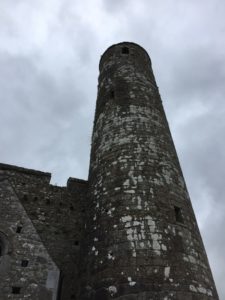
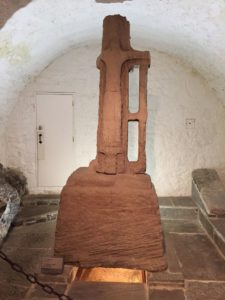
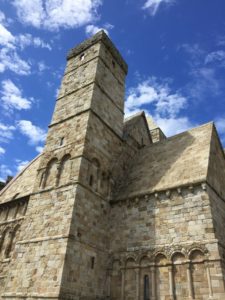
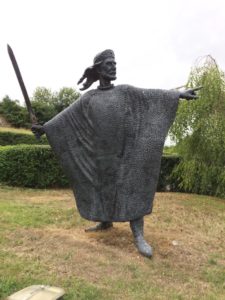
Kinsale

Our next overnight stay was in Kinsale in County Cork, a charming coastal town with meandering streets and an abundance of excellent restaurants and lively pubs. The rainy weather did not deter us from exploring 12th century St. Multose church (whose graveyard included several passengers from the Lusitania, sunk offshore nearby) and Charles Fort, a late 17th century fort associated with some of the most momentous events in Irish history, including the Williamite (1689–91) and Civil (1922–23) wars. Our group dinner at Man Friday included a swoon-worthy raspberry meringue dessert, and Beth and I had a second delicious dinner the next night at Jim Edwards Restaurant.
Joe was eager to introduce us to the Kinsale nightlife, with an assortment of pubs offering lively traditional music. After our group dinner the first evening, some intrepid souls in our group, facing the packed crowd in Daltons Bar, were treated to a wonderful trad session featuring a group of seasoned musicians and a selection of “not for public consumption” sing-along pieces. Joe’s rendition of a song he claimed his grandmother sang to him as a child, about a woman who murders her “babbie” with a pair of sewing scissors, was a hilarious highlight. Much Guinness and Redbreast 12 whisky was consumed. The next evening offered a variety of live music options, and we had a post-dinner brew listening to more trad music in the Armada.


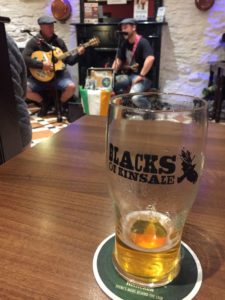
Kenmare and Kilkenny
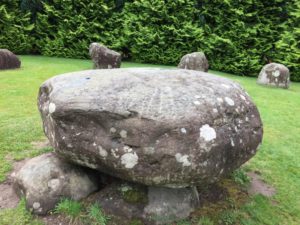
Heading south into County Kerry, we stopped for lunch in Kenmare. I was super excited to learn that the village of Kenmare boasts a stone circle, as so far we had not visited any neolithic sites in our travels. The largest of about a hundred circles in southwest Ireland, this specimen, only a short walk away from the central park and shopping street, also includes a center “boulder dolmen” burial monument rarely found outside of this part of Ireland. During our lunch stop, I also visited the Kenmare Lace & Design Centre, which had a lovely display of traditional needlepoint lace. This skill was introduced by the nuns of St. Clare’s Convent during the 1800s in response to the poverty following the Great Famine; original local designs have won acclaim in exhibitions around the world. Today, lacemakers are at work in the centre, and teach the craft to a new generation.
In the afternoon, we had a wet drive through scenic Killarney National Park, a wet but informative and entertaining herding demonstration at Kissane Sheep Farm (those dogs are really good, and didn’t mind the rain at all), and a wet (in a different sense) “happy half hour” stop at the Anvil Pub in Castlemaine to warm up with some Irish coffee, before arriving at our lodgings in Dingle, where we would spend the next three nights.